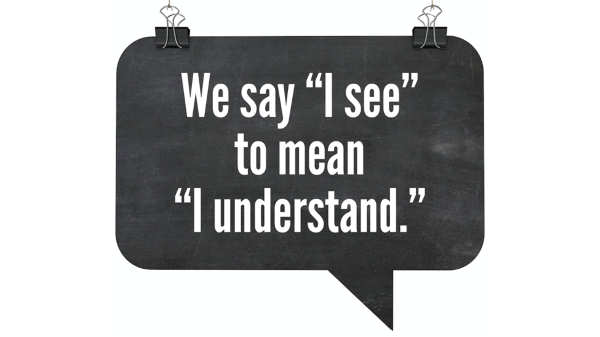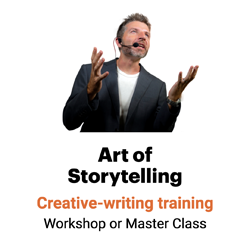There’s a 1:1 correlation between vivid descriptions and comprehension
Three professors from Texas A&M University and the University of the Andes aimed to find out whether concrete images or abstract images were more understandable.

First, the professors (Sadoski, Goetz and Rodriguez, 2000) crafted a series of passages. Each passage was 56 words long and written at about the same level of readability.
Half of the passages were abstract:
The other half were concrete:
Then the researchers asked 40 graduate students to read the passages and rate them for how interesting and easy to understand they were.
The students rated the concrete copy more interesting and understandable.
1. Concrete detail is easier to understand.
In fact, there was almost a one-to-one correlation between how concrete a passage was and how easy it was to understand, the researchers said.
Next, the researchers wrote a series of abstract and concrete headlines for each of the 56-word passages. They included:
Abstract headline |
Concrete headline |
| Domestic Devices | Countertop Gadgets |
| Preferred Items | Favorite Junk |
| The Laws of Lift | How a Plane Flies |
| A Science Find | Jungles in Ice |
| Mortal Justice | Death Penalty |
Then they asked the graduate students to rate the headlines for how interesting and easy to understand they were.
The students rated the concrete headlines much more understandable and interesting.
“Using more concrete language and content,” Sadoski, Goetz and Rodriguez write, “should have positive effects in making … text more comprehensible, interesting and memorable.”
Concrete headlines are also more memorable.
2. Vivid descriptions boost learning.
We’ve known this for years.
In the early 19th century, German philosopher Johann Friedrich Herbart said that interest leads to understanding, learning and memory — and even inspires readers to learn more.
For some 200 years, researchers, philosophers and communicators have found Herbart’s link between interest and learning to be true.
One of those researchers is Suzanne Hidi, associate member at the Ontario Institute for Studies in Education’s Centre for Applied Cognitive Science. She reviewed the research connecting interest with learning.
“Interesting copy,” Hidi found, is:
- Concrete. Concrete images show instead of tell, turning ideas into things. They are also filled with action and images.
- Emotional. Concrete imagery includes human interest, narrative action and “life themes” readers can identify with.
- Novel. Concrete detail is surprising or unexpected.
Here, for instance, are some of the concrete, interesting sentences that researchers have studied:
- The huge gorilla smashed the bus with its fist. (Anderson, 1982)
- When a Click Beetle is on its back, it flips itself into the air and lands right side up while it makes a clicking noise. (Garner et al., 1989)
- When a fly moves its wings about 200 times in a second, you hear a buzzing sound. (Garner et al., 1989)
- No advertising is allowed on Swedish television, and there are no commercial stations. (Hidi & Baird, 1983)
- Adult wolves carry food home in their stomachs and bring it up again or regurgitate it for the young cubs to eat. It’s the wolf version of canned baby food. (Hidi & Baird, 1983)
- Thomas Edison became the most famous inventor of all time even though he left school when he was only 6 years old. (Hidi & Baird, 1988)
- A canary can also bluff by playing dead. A frightened canary may go limp in someone’s hand. (Hidi & Baird, 1983)
- The Battle of Trafalgar was the greatest naval victory in British history, and it was the war for Great Britain. (Wade & Adams, 1990)
- [Lady Emma Hamilton] fell in love with the battered, one-eyed, one-armed naval hero and became his mistress. (Wade & Adams, 1990)
Concrete imagery, according to Hidi’s review of the literature:
- Encourages reading (Hidi & Baird, 1986).
- Improves comprehension (Hidi & Baird, 1986; Bernstein, 1955).
- Boosts learning (Hidi & Baird, 1986; Shirey and Reynolds, 1988).
- Increases recall (Hidi & Baird, 1988).
- Helps people come up with bigger, better, more creative ideas (Bernstein, 1955).
Nearly 45 years of research proves it: Concrete details help readers understand; abstract images aren’t so helpful. For instance:
- The entire incoming first-year class of a college participated in a study where researchers rewrote passages from American history textbooks to make them more concrete. Students understood the revised, concrete passages much better than the original ones. They also rated the revised passages significantly more interesting (Wharton, 1980).
- Students understood and remembered concrete words (PDF) better than abstract language. Concrete words included aisle, ceremony, scene and pile. Abstract ones included pride, theory, time and truth (Sadoski, Goetz, Stricker and Burdenski, 2003).
- Students understood the plot and theme of a story better if the words painted a mental picture of a key event in the story. (Sadoski 1983, 1985).
- Undergraduates understood history textbook passages better when the message was more concrete and full of images. They also found concrete passages much more interesting. (Wharton).
- Abstract language is more vague, and that makes it harder to understand and remember, researchers have found. (B.J. O’Neill and Allan Paivo).
So how can you make your abstract ideas concrete?
3. Word pictures boost understanding by 43%.
Readers don’t understand abstract words — those that refer to ideas — very well, according to a study by Prabu David and Jagdeep Kang. But, according to the study, if you:
- Use concrete, visual words — words that paint pictures in readers’ heads — you can increase understanding by 43%.
- Add an actual picture to a word picture, you can increase understanding by 76%.
For the study, researchers used an infographic and accompanying text from a USA Today article about the effects of nicotine on the body. They tested abstract copy and concrete copy and found that word pictures increased understanding dramatically.
Why? Because concrete imagery — word pictures — paint pictures in your readers’ minds.
Help readers see with concrete information.
That’s no surprise. After all, we say “I see” to mean “I understand.”

So help them see.
Turn ideas into things: Make your message more vivid and visual with concrete information, and people will literally see what you mean.
Are you turning ideas into things? Or are you hoping to gain understanding with abstractions?
____
Sources:
Suzanne Hidi, “Interest and Its Contribution as a Mental Resource for Learning,” Review of Educational Research, Winter 1990, Vol. 60, No. 4, pp. 549-571
Prabu David and Jagdeep Kang, “Pictures, High-Imagery News Language and News Recall,” Newspaper Research Journal, Summer 1998
Mark Sadoski, Ernest T. Goetz and Maximo Rodriguez, “Engaging Texts: Effects of Concreteness on Comprehensibility, Interest, and Recall in Four Text Types.” Journal of Educational Psychology 92, 2000, pp. 85-95

Leave a Reply